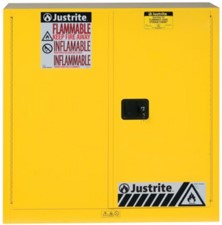Safety and Loss Prevention
Flammable Liquid Storage Cabinets

These are suitable for flammable and combustible liquids. Specific requirements are outlined in the California Fire Code (2025) Section 5704.3.2.
Design and Construction. Shall be in accordance with the following:
Materials. Cabinets shall be listed in accordance with UL 1275, or constructed of approved wood or metal in accordance with the following:
- Unlisted metal cabinets shall be constructed of steel having a thickness of not less than 0.044 inch (1.12 mm) (18 gage). The cabinet, including the door, shall be double walled with 1 ½-inch (38 mm) airspace between the walls. Joints shall be riveted or welded and shall be tight fitting.
- Unlisted wooden cabinets, including doors, shall be constructed of not less than 1-inch (25 mm) exterior grade plywood. Joints shall be rabbeted and shall be fastened in two directions with wood screws. Door hinges shall be of steel or brass. Cabinets shall be painted with an intumescent-type paint. [An intumescent is a substance that swells as a result of heat exposure, thus increasing in volume and decreasing in density. Intumescent materials used in fire protection will increase their volume significantly under the influence of heat (approximately at 200°C). This physical process is one of the main principles for passive fire protection products: Intumescent sealants are able to close gaps in and around service penetration seals very quickly in the event that a fire occurs.]
Labeling. Cabinets shall be provided with a conspicuous label in red letters on contrasting background that reads: “FLAMMABLE – KEEP FIRE AWAY.”
Doors. Doors shall be well fitted, self-closing and equipped with a three-point latch.
Bottom. The bottom of the cabinet shall be liquid tight to a height of 2 inches (51 mm).
Capacity. The combined total quantity of flammable and combustible liquids in a cabinet shall not exceed 120 gallons (454 L).
